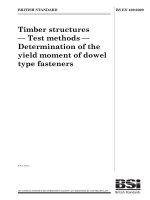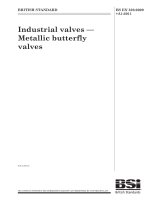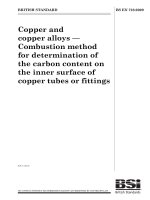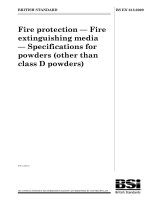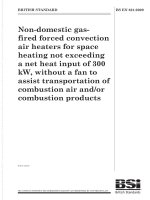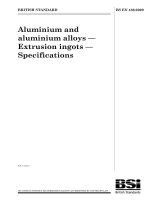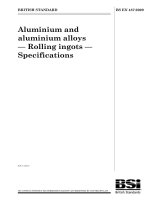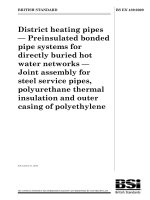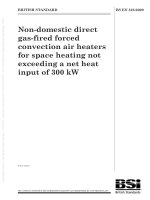Bsi bs en 62097 2009
Bạn đang xem bản rút gọn của tài liệu. Xem và tải ngay bản đầy đủ của tài liệu tại đây (2.06 MB, 88 trang )
BS EN 62097:2009
BSI British Standards
Hydraulic machines,
radial and axial —
Performance conversion
method from model to
prototype
NO COPYING WITHOUT BSI PERMISSION EXCEPT AS PERMITTED BY COPYRIGHT LAW
raising standards worldwide™
BRITISH STANDARD
BS EN 62097:2009
National foreword
This British Standard is the UK implementation of EN 62097:2009. It is identical to IEC 62097:2009.
The UK participation in its preparation was entrusted to Technical Committee
MCE/15, Hydraulic turbines.
A list of organizations represented on this committee can be obtained on
request to its secretary.
This publication does not purport to include all the necessary provisions of a
contract. Users are responsible for its correct application.
© BSI 2009
ISBN 978 0 580 54832 1
ICS 27.140
Compliance with a British Standard cannot confer immunity from
legal obligations.
This British Standard was published under the authority of the Standards
Policy and Strategy Committee on 31 July 2009
Amendments issued since publication
Amd. No.
Date
Text affected
BS EN 62097:2009
EUROPEAN STANDARD
EN 62097
NORME EUROPÉENNE
May 2009
EUROPÄISCHE NORM
ICS 27.140
English version
Hydraulic machines, radial and axial Performance conversion method from model to prototype
(IEC 62097:2009)
Machines hydrauliques,
radiales et axiales Méthode de conversion des performances
du modèle au prototype
(CEI 62097:2009)
Hydraulische Maschinen,
radial und axial Leistungsumrechnung
vom Modell zum Prototyp
(IEC 62097:2009)
This European Standard was approved by CENELEC on 2009-03-01. CENELEC members are bound to comply
with the CEN/CENELEC Internal Regulations which stipulate the conditions for giving this European Standard
the status of a national standard without any alteration.
Up-to-date lists and bibliographical references concerning such national standards may be obtained on
application to the Central Secretariat or to any CENELEC member.
This European Standard exists in three official versions (English, French, German). A version in any other
language made by translation under the responsibility of a CENELEC member into its own language and notified
to the Central Secretariat has the same status as the official versions.
CENELEC members are the national electrotechnical committees of Austria, Belgium, Bulgaria, Cyprus, the
Czech Republic, Denmark, Estonia, Finland, France, Germany, Greece, Hungary, Iceland, Ireland, Italy, Latvia,
Lithuania, Luxembourg, Malta, the Netherlands, Norway, Poland, Portugal, Romania, Slovakia, Slovenia, Spain,
Sweden, Switzerland and the United Kingdom.
CENELEC
European Committee for Electrotechnical Standardization
Comité Européen de Normalisation Electrotechnique
Europäisches Komitee für Elektrotechnische Normung
Central Secretariat: avenue Marnix 17, B - 1000 Brussels
© 2009 CENELEC -
All rights of exploitation in any form and by any means reserved worldwide for CENELEC members.
Ref. No. EN 62097:2009 E
BS EN 62097:2009
EN 62097:2009
-2-
Foreword
The text of document 4/242A/FDIS, future edition 1 of IEC 62097, prepared by IEC TC 4, Hydraulic
turbines, was submitted to the IEC-CENELEC parallel vote and was approved by CENELEC as
EN 62097 on 2009-03-01.
The International Standard contains attached files in the form of Excel file. These files are intended to be
used as complement and do not form an integral part of this publication.
The following dates were fixed:
– latest date by which the EN has to be implemented
at national level by publication of an identical
national standard or by endorsement
(dop)
2009-12-01
– latest date by which the national standards conflicting
with the EN have to be withdrawn
(dow)
2012-03-01
Annex ZA has been added by CENELEC.
__________
Endorsement notice
The text of the International Standard IEC 62097:2009 was approved by CENELEC as a European
Standard without any modification.
__________
BS EN 62097:2009
-3-
EN 62097:2009
Annex ZA
(normative)
Normative references to international publications
with their corresponding European publications
The following referenced documents are indispensable for the application of this document. For dated
references, only the edition cited applies. For undated references, the latest edition of the referenced
document (including any amendments) applies.
NOTE When an international publication has been modified by common modifications, indicated by (mod), the relevant EN/HD
applies.
Publication
Year
Title
EN/HD
Year
IEC 60193
1999
Hydraulic turbines, storage pumps and
pump-turbines - Model acceptance tests
EN 60193
1999
www.bzfxw.com
BS EN 62097:2009
–2–
62097 © IEC:2009
CONTENTS
INTRODUCTION.....................................................................................................................7
1
Scope ...............................................................................................................................9
2
Normative references .......................................................................................................9
3
Terms, definitions, symbols and units ...............................................................................9
3.1
3.2
4
System of units .......................................................................................................9
List of terms ............................................................................................................9
3.2.1 Subscripts’ list .............................................................................................9
3.2.2 Terms, definitions, symbols and units ........................................................ 10
Scale-effect formula ....................................................................................................... 13
4.1
5
General ................................................................................................................. 13
4.1.1 Scalable losses ......................................................................................... 13
4.1.2 Basic formulae of the scale effect on hydrodynamic friction losses ............ 15
4.2 Specific hydraulic energy efficiency ....................................................................... 17
4.2.1 Step-up formula ......................................................................................... 17
4.2.2 Roughness of model and prototype............................................................ 19
4.2.3 Direct step-up for a whole turbine .............................................................. 22
4.3 Power efficiency (disc friction) ............................................................................... 23
4.3.1 Step-up formula ......................................................................................... 23
4.3.2 Roughness of model and prototype............................................................ 23
4.4 Volumetric efficiency ............................................................................................. 24
Standardized values of scalable losses and pertinent parameters .................................. 24
6
5.1 General ................................................................................................................. 24
5.2 Specific speed....................................................................................................... 25
5.3 Parameters for specific hydraulic energy efficiency step-up ................................... 25
5.4 Parameters for power efficiency (disc friction) step-up........................................... 26
Calculation of prototype performance ............................................................................. 27
7
6.1 General ................................................................................................................. 27
6.2 Hydraulic efficiency ............................................................................................... 27
6.3 Specific hydraulic energy ...................................................................................... 28
6.4 Discharge .............................................................................................................. 28
6.5 Torque .................................................................................................................. 29
6.6 Power.................................................................................................................... 29
6.7 Required input data ............................................................................................... 30
Calculation procedure..................................................................................................... 31
www.bzfxw.com
Annex A (informative) Basic formulae and their approximation ............................................. 33
Annex B (informative) Scale effect on specific hydraulic energy losses of radial flow
machines .............................................................................................................................. 43
Annex C (informative) Scale effect on specific hydraulic energy losses of axial flow
machines [10] ....................................................................................................................... 63
Annex D (informative) Scale effect on disc friction loss ........................................................ 70
Annex E (informative) Leakage loss evaluation for non homologous seals ........................... 76
Bibliography.......................................................................................................................... 83
Figure 1 – Basic concept for step-up considering surface roughness .................................... 16
BS EN 62097:2009
62097 © IEC:2009
–3–
Figure 2 – IEC criteria of surface roughness given in Tables 1 and 2 .................................... 20
Figure 3 – Francis Runner blade and fillets ........................................................................... 21
Figure 4 – Runner blade axial flow ........................................................................................ 22
Figure 5 – Guide vanes......................................................................................................... 22
Figure 6 – Calculation steps of step-up values ...................................................................... 32
Figure A.1 – Flux diagram for a turbine ................................................................................. 34
Figure A.2 – Flux diagram for a pump ................................................................................... 35
Figure B.1 – Loss coefficient versus Reynolds number and surface roughness ..................... 44
Figure B.2 – Different characteristics of λ in transition zone.................................................. 45
Figure B.3 – Representative dimensions of component passages ......................................... 48
Figure B.4 – Relative scalable hydraulic energy loss in each component of Francis
turbine .................................................................................................................................. 54
Figure B.5 – Relative scalable hydraulic energy loss in each component of pumpturbine in turbine operation ................................................................................................... 55
Figure B.6 – Relative scalable hydraulic energy loss in each component of pumpturbine in pump operation ..................................................................................................... 56
Figure B.7 – κuCO and κdCO in each component of Francis turbine........................................ 57
Figure B.8 – κuCO and κdCO in each component of pump-turbine in turbine operation............ 58
Figure B.9 – κuCO and κdCO in each component of pump-turbine in pump operation ............. 59
Figure B.10 – d ECOref and d Eref for Francis turbine ............................................................... 60
Figure B.11 – d ECOref and d Eref for pump-turbine in turbine operation .................................. 61
www.bzfxw.com
Figure B.12 – d E COref and d Eref for pump-turbine in pump-operation .................................... 62
Figure C.1 – δ Eref for Kaplan turbines ................................................................................... 66
Figure D.1 – Disc friction loss ratio δ Tref ............................................................................... 72
Figure D.2 – Dimension factor κT .......................................................................................... 74
Figure D.3 – Disc friction loss index d Tref .............................................................................. 75
Figure E.1 – Examples of typical design of runner seals (crown side) ................................... 78
Figure E.2 – Examples of typical design of runner seals (band side) ..................................... 79
Table 1 – Maximum recommended prototype runner roughness for new turbines (μm) .......... 21
Table 2 – Maximum recommended prototype guide vane roughness for new turbines
(μm)...................................................................................................................................... 22
Table 3 – Permissible deviation of the geometry of model seals from the prototype .............. 24
Table 4 – Scalable loss index d ECOref and velocity factor κuCO for Francis turbines............... 25
Table 5 – Scalable loss index d ECOref and velocity index κuCO for pump-turbines in
turbine operation................................................................................................................... 26
Table 6 – Scalable loss index d ECOref and velocity index κuCO for pump-turbines in
pump operation ..................................................................................................................... 26
Table 7 – Scalable loss index d ECOref and velocity factor κuCO for axial flow machines ......... 26
Table 8 – Required input data for the calculation of the prototype performance .................... 30
Table B.1 – d Eref and κu0 for step-up calculation of whole turbine ......................................... 51
Table B.2 – Criteria for the surface roughness for the application of the direct step-up
formula ................................................................................................................................. 52
BS EN 62097:2009
–4–
Table C.1 – Ratio of
62097 © IEC:2009
dEST
for Francis turbines and pump-turbines ...................................... 68
δ EST
Table C.2 – Parameters to obtain Δ ECO for axial flow machines ............................................ 68
www.bzfxw.com
BS EN 62097:2009
62097 © IEC:2009
–7–
INTRODUCTION
0.1
General remarks
This International Standard establishes the prototype hydraulic machine efficiency from model
test results, with consideration of scale effect including the effect of surface roughness.
Advances in the technology of hydraulic turbo-machines used for hydroelectric power plants
indicate the necessity of revising the scale effect formula given in 3.8 of IEC 60193. [1] 1 The
advance in knowledge of scale effects originates from work done by research institutes,
manufacturers and relevant working groups within the organizations of IEC and IAHR. [1 - 7]
The method of calculating prototype efficiencies, as given in this standard, is supported by
experimental work and theoretical research on flow analysis and has been simplified for
practical reasons and agreed as a convention. [8 – 10] The method is representing the
present state of knowledge of the scale-up of performance from model to a homologous
prototype.
Homology is not limited to the geometric similarity of the machine components, it also calls for
homologous velocity triangles at the inlet and outlet of the runner/impeller. [2] Therefore,
compared to IEC 60193, a higher attention has to be paid to the geometry of guide vanes.
According to the present state of knowledge, it is certain that, in most cases, the formula for
the efficiency step-up calculation given in the IEC 60193 and earlier standards, overstated the
step-up increment of the efficiency for the prototype. Therefore, in the case where a user
wants to restudy a project for which a calculation of efficiency step-up was done based on any
previous method, the user shall re-calculate the efficiency step-up with the new method given
in this standard, before restudying the project of concern.
www.bzfxw.com
This standard is intended to be used mainly for the assessment of the results of contractual
model tests of hydraulic machines. If it is used for other purposes such as evaluation of
refurbishment of machines having very rough surfaces, special care should be taken as
described in Annex B.
Due to the lack of sufficient knowledge about the loss distribution in Deriaz turbines and
storage pumps, this standard does not provide the scale effect formula for them.
An excel work sheet concerning the step-up procedures of hydraulic machine performance
from model to prototype is indicated at the end of this Standard to facilitate the calculation of
the step-up value.
0.2
Basic features
A fundamental difference compared to the IEC 60193 formula is the standardization of
scalable losses. In a previous standard (see 3.8 of IEC 60193:1999 [1]), a loss distribution
factor V has been defined and standardized, with the disadvantage that turbine designs which
are not optimized benefit from their lower technological level.
This is certainly not correct, since a low efficiency design has high non-scalable losses, like
incidence losses, whereby the amount of scalable losses is about constant for all
manufacturers, for a given type and a given specific speed of a hydraulic machine.
This standard avoids all the inconsistencies connected with IEC 60193:1999. (see 3.8 of [1])
A new basic feature of this standard is the separate consideration of losses in specific
hydraulic energy, disc friction losses and leakage losses. [5], [8 – 10]
—————————
1 Numbers in square brackets refer to the bibliography.
BS EN 62097:2009
–8–
62097 © IEC:2009
Above all, in this standard, the scale-up of the hydraulic performance is not only driven by the
dependence of friction losses on Reynolds number Re, but also the effect of surface
roughness Ra has been implemented.
Since the roughness of the actual machine component differs from part to part, scale effect is
evaluated for each individual part separately and then is finally summed up to obtain the
overall step-up for a complete turbine. [10] For radial flow machines, the evaluation of scale
effect is conducted on five separate parts; spiral case, stay vanes, guide vanes, runner and
draft tube. For axial flow machines, the scalable losses in individual parts are not fully
clarified yet and are dealt with in two parts; runner blades and all the other stationary parts
inclusive.
The calculation procedures according to this standard are summarized in Clause 7 and Excel
sheets are provided as an Attachment to this standard to facilitate the step-up calculation.
In case that the Excel sheets are used for evaluation of the results of a contractual model
test, each concerned party shall execute the calculation individually for cross-check using
common input data agreed on in advance.
www.bzfxw.com
BS EN 62097:2009
62097 © IEC:2009
–9–
HYDRAULIC MACHINES, RADIAL AND AXIAL –
PERFORMANCE CONVERSION METHOD
FROM MODEL TO PROTOTYPE
1 Scope
This International Standard is applicable to the assessment of the efficiency and performance
of prototype hydraulic machine from model test results, with consideration of scale effect
including the effect of surface roughness.
This standard is intended to be used for the assessment of the results of contractual model
tests of hydraulic machines.
2 Normative references
The following referenced documents are indispensable for the application of this document.
For dated references, only the edition cited applies. For undated references, the latest edition
of the referenced document (including any amendments) applies.
IEC 60193:1999, Hydraulic turbines, storage pumps and pump-turbines – Model acceptance
tests
www.bzfxw.com
3 Terms, definitions, symbols and units
3.1 System of units
The International System of Units (SI) is used throughout this standard. All terms are given in
SI Base Units or derived coherent units. Any other system of units may be used after written
agreement of the contracting parties.
3.2 List of terms
For the purposes of this document, the terms and definitions of IEC 60193 apply, as well as
the following terms, definitions, symbols and units.
3.2.1
Subscripts’ list
Term
Symbol
model
M
prototype
P
specific energy
Term
Symbol
component
CO
E
spiral case
SP
volumetric
Q
stay vane
SV
torque or disc friction
T
guide vane
GV
reference
ref
runner
RU
hydraulic diameter
d
draft tube
DT
velocity
u
stationary part
ST
hydraulic
h
optimum point
opt
off design point
off
in general term
represented by
CO
BS EN 62097:2009
– 10 –
3.2.2
62097 © IEC:2009
Terms, definitions, symbols and units
Term
Definition
Symbol
Unit
Radial flow machines
Francis turbines and Francis type reversible pump-turbines
-
-
Axial flow machines
Kaplan turbines, bulb turbines and fixed blade propeller
turbines
-
-
Reference diameter
Reference diameter of the hydraulic machine
D
m
(see Figure 3 of IEC 60193)
Hydraulic diameter
4 times sectional area divided by the circumference of the
section
dh
m
Sand roughness
Equivalent sand roughness [11]
kS
m
Arithmetical mean
roughness
Deviation of the surface profile represented by the
arithmetical mean value
Ra
m
Acceleration due to
gravity
Local value of gravitational acceleration at the place of
testing as a function of altitude and latitude (see
IEC 60193)
g
m s –2
Density of water
Mass per unit volume of water (see IEC 60193)
ρ
kg m –3
Dynamic viscosity
A quantity characterizing the mechanical behaviour of a
fluid
μ
Pa s
Kinematic viscosity
Ratio of the dynamic viscosity to the density of the fluid.
Values are given as a function of temperature. (see
IEC 60193)
ν
m 2 s –1
Discharge
Volume of water per unit time flowing through any section
in the system
Q
m 3 s –1
Mass flow rate
Mass of water flowing through any section of the system
per unit time
Discharge of machine
Discharge flowing through the high pressure reference
section
Leakage flow rate
www.bzfxw.com
(ρ Q)
kg s –1
Q1
m 3 s –1
Volume of water per unit time flowing through the runner
seal clearances
q
m 3 s –1
Net discharge
Volume of water per unit time flowing through
runner/impeller. It corresponds to Q 1 -q in case of turbine
and Q 1 +q in case of pump.
Qm
m 3 s –1
Mean velocity
Discharge divided by the sectional area of water passage
v
m s –1
Peripheral velocity
Peripheral velocity at the reference diameter
u
m s –1
Rotational speed
Number of revolutions per unit time
n
S –1
Specific hydraulic
energy of machine
Specific energy of water available between the high and
low pressure reference sections 1 and 2 of the machine
taking into account the influence of compressibility (see
IEC 60193)
E
J kg –1
Specific hydraulic
energy of
runner/impeller
Turbine: Net specific hydraulic energy working on the
runner
Em
J kg –1
Em
J kg –1
Pump: Specific hydraulic energy produced by the impeller
Specific hydraulic
energy loss in
stationary part
Specific hydraulic energy loss in stationary part which
includes both friction loss and kinetic loss
E Ls
J kg –1
Specific hydraulic
energy loss in
runner/impeller
Specific hydraulic energy loss in runner/impeller which
includes both friction loss and kinetic loss
E Lm
J kg –1
Friction loss of
specific hydraulic
energy
Specific hydraulic energy loss caused by the friction on the
surface of water passages
E Lf
J kg –1
BS EN 62097:2009
62097 © IEC:2009
– 11 –
Term
Definition
Symbol
Unit
Kinetic loss of
specific hydraulic
energy
Specific hydraulic energy loss caused by the hydraulic
phenomena other than surface friction, such as turbulence,
separation of flow, abrupt change of water passage, etc.
E lk
J kg –1
Turbine net head or
pump delivery head
H=E/g
H
m
Turbine output or
pump input
The mechanical power delivered by the turbine shaft or to
the pump shaft, assigning to the hydraulic machine the
mechanical losses of the relevant bearings and shaft seals
(see Figures A.1 and A.2)
P
W
Hydraulic power
The power available for producing power (turbine) or
imparted to the water (pump)
Ph
W
P h = E (ρQ 1 )
Mechanical power of
runner/ impeller
The power transmitted through the coupling between shaft
and runner (impeller).
Pm
W
Power of
runner/impeller
Turbine: Power produced by the runner corresponding to
E m (ρQ m ) or P m +P Ld
Pr
W
Pr
W
Pump: Power produced by the impeller represented by
E m (ρQ m ) or P m -P Ld
Disc friction loss
Loss power caused by the friction on the outer surface of
the runner/impeller
P Ld
W
Bearing loss power
Loss power caused by the friction of the shaft bearing and
shaft seal
P Lm
W
Runner/impeller
torque
Torque transmitted through the coupling of the
runner/impeller and the shaft corresponding to the
mechanical power of runner/impeller, P m .
Tm
Nm
Hydraulic efficiency
Turbine: η h =P m /P h
ηh
-
Specific hydraulic
energy efficiency
Turbine: η E = E m /E h
ηE
-
Pump: η Q = Q 1 /Q m
ηQ
-
Pump : η T = P r /P m
ηT
-
Pump: η m = P m /P
ηm
-
Volumetric efficiency
(see Figures A.1 and A.2)
Turbine: η Q = Q m /Q 1
www.bzfxw.com
Pump: η h =P h /P m
Pump: η E = E h /E m
(see Figures A.1 and A.2)
Power efficiency (disc
friction efficiency)
Turbine : η T = P m /P r
Mechanical efficiency
Turbine: η m = P/P m
(see Figures A.1 and A.2)
Efficiency step-up
Difference between efficiencies at two hydraulically similar
operating conditions
Δη
Efficiency step-up
ratio
Ratio of efficiency step-up against model efficiency
Δ
(see Figures A.1 and A.2)
Δ=
Reynolds number
Δη
ηM
Reynolds number of the machine
Re
-
Re d
-
λ
-
Re = D u / ν
Reynolds number of
component passage
Re d = d h v / ν
Friction loss
coefficient for pipe
flow
Friction loss coefficient for a pipe.
λ =
E Lf
L v2
d 2
where d pipe diameter (m)
L pipe length (m)
BS EN 62097:2009
– 12 –
Term
Friction loss
coefficient for a flat
plate
Definition
Friction loss coefficient for a flat plate.
Cf =
62097 © IEC:2009
Symbol
Unit
Cf
-
Cm
-
δE
-
δns
-
E Lf
BL w 3
Q 2
where B width of a flat plate (m)
L length of a flat plate (m)
Q discharge passing by the plate (m 3 /s)
w relative flow velocity (m/s)
Disc friction loss
coefficient
Friction loss coefficient for a rotating disc
Cm =
PLd
4
π
ρ n 3D d 5
8
where
D d diameter of the rotating disc (m)
Relative scalable
hydraulic energy loss
Scalable specific hydraulic energy loss divided by E, which
is dependent on Reynolds number and roughness (in most
cases, it is represented in %)
δ E = E lf /E
Relative non-scalable
hydraulic energy loss
Non-scalable specific hydraulic energy loss divided by E,
which remains constant regardless of Reynolds number
and roughness
δ ns = E lk /E
www.bzfxw.com
Reference scalable
hydraulic energy loss
δ E value for a model with smooth surface operating at a
reference Reynolds number Re = 7 ×10 6
Reference scalable
hydraulic energy loss
in component
passage
δ Eref for each component passage
Relative disc friction
loss
Disc friction loss
δT =
P Ld divided by P m
δ Eref
-
δ ECOref
-
δT
-
PLd
Pm
Reference disc
friction loss
δ T value for a model with fairly smooth surface operating at
δTref
-
Flow velocity factor
for each component
passage
Ratio of the maximum relative flow velocity in each
component passage against the peripheral velocity u
κ uCO
-
κ dCO
-
a reference Reynolds number Re = 7 × 10 6
κ uCO =
Dimension factor for
each component
passage
v CO
u
Ratio of the hydraulic diameter of each component
passage against the reference diameter
κ dCO =
d hCO
D
BS EN 62097:2009
62097 © IEC:2009
– 13 –
Term
Dimension factor for
disc friction loss
Definition
Ratio of the diameter of the runner crown or runner band
against the reference diameter
κT =
Symbol
Unit
κT
-
d ECOref
-
d Tref
-
V
-
N QE
-
Dd
D
D d : diameter of the runner crown or the runner band,
whichever larger
Scalable hydraulic
energy loss index for
each component
passage
Scalable disc friction
loss index
Loss distribution
factor
dECOref =
d Tref =
Energy coefficient
Discharge coefficient
Power coefficient
1 + 0,154 κ T
nQ10,5
N QE =
Power factor
δ Tref
)
0 ,2
0,4
δ
1 − ηh
Specific speed
Discharge factor
1 + 0,351 (κ uCO × κ dCO
Ratio of scalable loss to total loss
V=
Speed factor
δ ECOref
E 0,75
nD
n ED =
E 0,5
Q ED =
PED =
E nD =
Q nD =
PnD =
Q1
www.bzfxw.com
n ED
-
Q ED
-
P ED
-
E nD
-
Q nD
-
P nD
-
D 2E 0,5
Pm
2 1,5
ρ1D E
E
n 2D 2
Q1
nD 3
Pm
ρ1n 3 D 5
4 Scale-effect formula
4.1 General
4.1.1
Scalable losses
The energy flux through hydraulic machines and the various losses produced in the energy
conversion process in a hydraulic machine can be typically illustrated by the flux diagrams
shown in A.1. [4]
As a consequence, one of the main features of the new scale up formula as stated in this
standard is the separate consideration on three efficiency components. They are specific
BS EN 62097:2009
– 14 –
62097 © IEC:2009
hydraulic energy efficiency η E , volumetric efficiency η Q and power efficiency η T . In this
standard, scale effect on each of these efficiency components is considered.
Among the losses corresponding to these efficiency components, the following losses are
subject to scale effect by the difference of Reynolds number and the relative roughness. Then
these losses are referred to as “scalable losses” in this standard.
•
Specific hydraulic energy loss due to friction: ELf
•
Leakage loss: q
•
Disc friction loss: PLd
It is considered in this standard that the relative magnitude of each scalable loss to each
corresponding performance parameter, except for discharge, ( δ E = E Lf E and δ T = PLd Pm )
is given as a function of the specific speed for each type of machine.
ELf is the sum of the friction loss in various parts of the machine and it is expressed as the
sum of the friction loss in each component as E Lf =
∑ E LfCO . The scale effect on this loss is
caused by the difference of Reynolds number and relative roughness between model and
prototype and assessed by the formula shown as Equation 1.
The rest of the specific hydraulic energy loss is called “kinetic loss" or “non-scalable loss" and
E LkCO . It is considered that the ratio of ELk against E m remains the
expressed as E Lk =
∑
same through the model and the prototype.
www.bzfxw.com
The scale effect on the leakage loss, q, is caused by the change of the friction loss coefficient
of the seal clearance of the runner/impeller. In most cases, the leakage loss itself is minor
and the scale effect on this loss is relatively very small.
Therefore, in case that the geometry of the seal is maintained homologous between the model
and the prototype within the criteria given in Table 3, the scale effect on the leakage loss is
disregarded and η Q of the prototype is considered to be the same as that of the model. (See
E.3)
In case that the geometry of the model is not homologous to the prototype, this standard
recommends to use the correction formula for η Q as set out in E.2.
Similarly to ELf , the scale effect on the disc friction PLd is caused by the difference in
Reynolds number and the relative roughness of the outer surface of the runner/impeller
between the model and the prototype. Due to the presence of the radial flow and the distortion
of the boundary layer in the limited space between the runner/impeller and the stationary
parts, the scale effect on PLd appears in a slightly different manner than on ELf . It is
considered in this standard that the scale effect on the disc friction may be assessed by a
scale effect formula shown as Equation 7. (See Annex D)
In case of axial flow machines, the friction loss of the surface of runner hub is negligibly small
and its scale effect is disregarded.
Therefore, in this standard, only the scale effect on the losses corresponding to the efficiency
components; η E and η T , are considered for radial flow machines and only η E is considered for
axial flow machines.
BS EN 62097:2009
62097 © IEC:2009
4.1.2
– 15 –
Basic formulae of the scale effect on hydrodynamic friction losses
Another new feature of the new scale effect formula is the consideration of surface
roughness. The basic physical background for consideration of surface quality is the
Colebrook diagram. By some manipulation and simplification, the implicit Colebrook formula
can be converted into as expression as shown below. [4, 6]
0,2
⎡
⎤
⎛
k
Re 0 ⎞
⎥
⎟
+
λ = λ 0 ⎢0,74⎜⎜ 8 × 10 4 × S +
0
,
26
⎢
⎥
dh
Re d ⎟⎠
⎝
⎣
⎦
(1)
where
Re 0 = 7 × 10 6
λ 0 = 0,008 5
kS
sand roughness
dh
hydraulic diameter of the water passage
Re d
Reynolds number of the water passage Re d =
dh × v
d ×v
Re
= h
D×u
ν
Practically, the surface roughness of model and prototype are represented by the arithmetical
mean roughness Ra as stated in 4.2.2. Regarding the relationship between the sand
roughness k S and Ra, wide spread results have been reported so far. In this standard,
however, it is considered that the relationship can be expressed by the following formula:
kS
Ra
≅5
dh
dh
www.bzfxw.com
(2)
NOTE For very rough surfaces, considerations as described in (2) and in Note 2 of B.1 should be taken into
account.
Then, Equation 1 is rewritten as follows;
0,2
⎡
⎤
⎛
Re 0 ⎞
Ra
D×u
⎟⎟
λ = λ 0 ⎢0,74⎜⎜ 4 × 10 5 ×
+
×
+ 0,26⎥
⎢
⎥
dh
dh × v
Re ⎠
⎝
⎣
⎦
(3)
Figure 1 sketches the basic concept for the step-up from model to prototype conditions
including surface roughness. Example P 3 shows the case of a smooth prototype machine. P 2
shows the case of a prototype machine of reasonable roughness, whereby P 1 shows the
example of a very rough surface where even a decrease of efficiency compared to the model
will occur.
BS EN 62097:2009
62097 © IEC:2009
– 16 –
Rough surface
Smooth surface
P1
M
λ
P2
P3
ReM
ReP
IEC
Re
201/09
Figure 1 – Basic concept for step-up considering surface roughness
In order to calculate the difference of hydraulic efficiency between two hydraulically similar
operating points M and P at different Reynolds numbers and different surface roughness
conditions, the following formulae can be derived by using Equation 3 (see A.2 (2)).
www.bzfxw.com
ΔE =
⎛ λ − λP
ΔηE
= δEref ⎜⎜ M
ηEM
⎝ λ ref
⎞
⎟
⎟
⎠
(4)
The Colebrook diagram is valid for pipe flow, but it can be demonstrated that also friction loss
coefficients of flat plate flow can be approximated with sufficient accuracy by similar
equations as shown below.
⎡
⎛
k
Re 0
C f = C f 0 ⎢0,80⎜⎜10 5 S +
⎢
L
Re f
⎝
⎣
⎞
⎟⎟
⎠
0,2
⎤
+ 0,20⎥
⎥
⎦
(5)
⎡
⎛
Ra D × u Re 0 ⎞
⎟
= C f 0 ⎢0,80⎜ 5 × 10 5
+
×
L
L×w
Re ⎠
⎢
⎝
⎣
0,2
⎤
+ 0,20⎥
⎥
⎦
where
Re 0 = 7 × 10 6
C f0 = 0,003 2
Re f
Reynolds number of the plate Re f =
L
length of the plate
w
relative flow velocity on the plate
L×w
L×w
=
Re
ν
D×u
By replacing λ in Equation 4 by C f given by Equation 5, Equation 4 is used to calculate the
scale effect of the friction loss of runner blades of axial flow machines.
BS EN 62097:2009
62097 © IEC:2009
– 17 –
Similar formula of friction loss coefficient for disc friction is established as follows [9];
(See Annex D).
⎡
⎛
k
Re0
Cm = Cm0 ⎢0,85⎜⎜1,5 × 10 4 × ST +
⎢
a
ReT
⎝
⎣
⎞
⎟
⎟
⎠
0,2
⎤
+ 0,15⎥
⎥
⎦
0,2
⎡
⎤
⎛
D2
Re0 ⎞⎟
4 RaT
⎢
⎜
+ 0,15⎥
= Cm0 0,85 7,5 × 10
+
×
2
⎢
⎥
⎟
⎜
a
Re
2
a
⎠
⎝
⎢⎣
⎥⎦
(6)
where
Re 0 = 7 × 10 6
C m0 = 0,001 9
k ST
equivalent sand roughness corresponding to Ra T
k ST =5Ra T
Ra T
weighted average of the arithmetical mean roughness of the outer surface of the
runner and the surface of the stationary part facing to the runner as given by
Equation 13
Re T
Reynolds number of the disc
2
Re T =
D
a 2ω a 2ω
2a 2
=
Re = 2 Re = d 2 Re
ν
Du
D
2D
a radius of runner crown or band, whichever larger (m)
www.bzfxw.com
a=
Dd
2
ω angular velocity of the disc (rad/s)
By using Equation 6, step-up formula for power efficiency (disc friction) is obtained as follows
(see A.2 (4)):
ΔT =
⎛C
ΔηT
− CmP
= δ Tref ⎜⎜ mM
ηTM
⎝ Cmref
⎞
⎟⎟
⎠
(7)
4.2 Specific hydraulic energy efficiency
4.2.1
Step-up formula
The scalable losses δ Eref as appeared in Equation 4 are referred to those of a model with
smooth surface operating at a reference Reynolds number Reref = 7 × 10 6 and have been
established as a function of type and specific speed of a hydraulic machine. They are
standardized and set out in Annex B for radial flow machines and Annex C for axial flow
machines.
By putting the new scale effect formula Equation 3 into Equation 4, the following formula for
the individual step-up for a machine component is derived (see B.2).
BS EN 62097:2009
– 18 –
Δ ECO =
Δ η ECO
= δ ECOref
η EM
= δ ECOref
⎛ λ COM − λ COP
⎜
⎜
λ COref
⎝
62097 © IEC:2009
⎞
⎟
⎟
⎠
0,2
⎡⎛
⎛
Ra COM
Ra COP
7 × 10 6 ⎞⎟
7 × 10 6
⎢ ⎜ 4 × 10 5 κ
+
− ⎜ 4 × 10 5 κ uCO
+
uCO
⎢⎜
⎜
Re P
DM
Re M ⎟⎠
DP
⎝
⎢⎝
⎢
1 + 0,35 (κ uCO × κ dCO )0,2
⎢
⎢
⎣
⎡⎛
Ra COM
7 × 10 6
= d ECOref ⎢⎜ 4 × 10 5 κ uCO
+
⎢⎜
DM
Re M
⎣⎢⎝
⎞
⎟
⎟
⎠
0,2
⎛
Ra COP
7 × 10 6
− ⎜ 4 × 10 5 κ uCO
+
⎜
DP
Re P
⎝
⎞
⎟
⎟
⎠
⎞
⎟
⎟
⎠
⎤
⎥
⎥
⎥
⎥
⎥
⎥
⎦
0,2
(8)
0,2 ⎤
⎥
⎥
⎦⎥
where
δ ECOref
standardized reference scalable loss for each component passage when the
machine Reynolds number Re M is equal to the reference Reynolds number
( 7 × 10 6 )
(see A.2 (2) and B.2 (2))
κ uCO
standardized flow velocity factor for each component passage (see B.2 (1))
κ dCO
standardized dimension factor for each component passage (see B.2 (1))
δ ECOref
scalable loss index for each component passage (see B.2 (2))
dECOref =
www.bzfxw.com
δ ECOref
1 + 0,35(κ uCO × κ dCO )0,2
For radial flow machines, Equation 8 allows to calculate the individual step-ups in the various
components, using d ECOref and κuCO which have been established for each individual
component from spiral case to draft tube.
The values of d ECOref and κuCO for each component passage of Francis turbine and pumpturbine are standardized and shown in 5.3 (1) and (2).
For axial flow machines, the scalable loss is divided into two parts, runner blades and
stationary parts. The efficiency step-up ratio for the scalable loss of stationary parts, Δ EST ,
can be obtained by Equation 8 in the same way as for radial flow machines. In this case, it is
considered that the representative flow velocity factor κ uST for all stationary parts can be
represented by 0,8 times the flow velocity factor for guide vanes; namely, κuST = 0,8 × κuGV .
The value of κ uST is shown in 5.3 (see Annex N of IEC 60193:1999 [1]).
As stated below Equation 5 in 4.1.2, scale effect formula for flat plate represented by
Equation 5 is supposed to be applied to runner blades. However, as demonstrated in C.2, the
scale effect formula based on Equation 5 can be transformed to the same formula as Equation
*
instead of κ uRU . Therefore, the
8 by introducing the modified flow velocity factor κ uRU
*
given in
following formula similar to Equation 8 can be applied to runner blades by using κ uRU
5.3 (see Annex N of IEC 60193:1999 [1]).
BS EN 62097:2009
62097 â IEC:2009
19
RaRUM
7 ì 106
ERU = dERUref ⎢⎜ 4 × 105 κ*uRU
+
⎢⎜
DM
ReM
⎣⎝
⎞
⎟
⎟
⎠
0,2
⎛
RaRUP
7 × 106
− ⎜ 4 × 105 κ*uRU
+
⎜
DP
ReP
⎝
⎞
⎟
⎟
⎠
0,2 ⎤
⎥
⎥
⎦
(9)
Then the step-up of the specific hydraulic energy for the whole machine can be calculated by
the equation below:
ΔE =
ΔηE
= ∑ Δ ECO
ηEM
(10)
The structure of formula is valid for all types of hydraulic reaction machines. Also it can be
applied for both turbines and pumps.
4.2.2
Roughness of model and prototype
When applying Equation 8 for the contractual model test to examine whether the model
efficiency meets the guarantee or not, the values of surface roughness (Ra) as stipulated
below shall be used in the formula.
–
Roughness of the model
The values measured on the model shall be used. The model components are known to
have a very good uniformity of roughness per component. When this is the case, 2 to 4
measuring points per component shall suffice. For repetitive components, like stay vanes,
guide vanes and runner blades, measurement on at least 2 repetitive components is
recommended.
–
Roughness of the prototype
www.bzfxw.com
Design values for the prototype roughness, which are offered by the supplier, shall be
used as the roughness of the prototype. When the turbine components are completed in
the factory, the surface roughness shall be measured and it should be verified that the
average value of the measured roughness of each component is equal or finer than the
design roughness for the component.
When applying Equation 8 for the assessment of the efficiency improvement in a rehabilitation
project, the roughness of the prototype components shall be measured on the existing unit.
The improvement of the efficiency achievable by the replacement of some components can be
assessed by comparing the efficiencies calculated with the roughness measured on the
existing components and with the design values for the new components.
In case of rehabilitation projects, roughness data of those components not to be replaced
shall be provided by the owner with the specification. For the measurement of rough surfaces
of old turbines, the recommendations described in Annex B (at the end of B.1) for Ra values
larger than 50 μm shall be taken into consideration.
When the roughness is measured on the model or the prototype, measurement shall be made
carefully so that the measured values may represent the roughness of each component
adequately.
For spiral case, stay vanes and draft tube, the sample points shall be selected so as to
represent the average roughness of the component correctly. For guide vanes and runner, the
sample points shall be selected so as to represent the average roughness of the high flow
velocity area of their passages. It is recommended to measure the roughness at sample
points as shown below and to use their arithmetic average for each component.
–
Spiral case: 9 points or more; at 3 radial sections: entrance, middle, end of casing.
–
2 Stay vane channels: 6 points or more per stay vane channel; 2 points per side of the
vane, 1 point on the top of the channel, 1 point on the bottom of the channel.
BS EN 62097:2009
62097 © IEC:2009
– 20 –
–
2 Guide vane channels: 10 points or more per guide vane channel between 2 guide vanes;
6 points on the inner side of the guide vane, 2 points on the outer side of the guide vane,
1 point on the top of the channel, 1 point on the bottom of the channel.
–
Runner: 20 points or more; with 70 % of them on the high flow velocity area (region A, as
defined in Table 1). The number of measuring points on pressure and suction sides of the
blade shall be identical.
–
Draft tube: 10 points or more; with 70 % of them upstream of the bend.
The surface roughness shall be measured as it appears in actual operation. Painted surface
shall be measured over the paint coat.
For axial flow machines, the roughness value given by Equation 11 shall be used as a
representative roughness for all stationary parts.
RaST =
Ra SV + Ra GV
2
(11)
As known by Equation 8, larger efficiency step-up can be achieved by polishing the prototype
finer. Nevertheless, the roughness of the prototype should not be finer than the roughness
expected after some period of operation (i.e. guaranteed period). Also, very fine polishing is
not cost effective, as shown in Figure 2.
IEC criteria
www.bzfxw.com
Cost
Efficiency
Efficiency
Cost
Fine
Rough
Roughness
IEC 202/09
Figure 2 – IEC criteria of surface roughness given in Tables 1 and 2
Tables 1 and 2 show the maximum recommended roughness for prototype runner and guide
vanes of new turbines. These recommended roughness values supersede those given in
IEC 60193.
BS EN 62097:2009
62097 © IEC:2009
– 21 –
Table 1 – Maximum recommended prototype runner roughness for new turbines ( μm)
E ≤ 3 000 J.kg –1
Reference diameter
Region
1m−2m
A
a
2m−4m
Ba
A
B
4m−7m
A
7 m − 10 m
B
b
Roughness (Ra)
Pressure side
2,3
3,2
6,3
12,5
12,5
25
Roughness (Ra)
Suction side
2,3
2,3
2,3
3,2
3,2
6,3
A
B
12,5
25 b
6,3
6,3
E > 3 000 J.kg –1
Reference diameter
Region
1m−2m
2m−4m
4m−7m
7 m − 10 m
A
B
A
B
A
B
A
B
Roughness (Ra)
Pressure side
2,3
2,3
2,3
3,2
3,2
6,3
6,3
6,3
Roughness (Ra)
Suction side
1,6
1,6
2,3
2,3
2,3
3,2
3,2
4,5
a Even though there are only 2 regions A and B in this table, it is well understood that an additional region
along the blade inflow edge is often polished to a very low roughness, in order to avoid initiation of
cavitation.
b These roughness values may seem excessive for these regions. However, the above values were
established based on comparable roughness losses between different machine sizes, having different
Reynolds number. So, bigger machines, having bigger Reynolds number can afford more roughness.
However, it is reasonable to use smaller roughness values than the ones recommended, if the parties
involved feel that it is more practical or more economical for the project concerned.
www.bzfxw.com
A
B
B
B
A
A
A
Turbine
-1
E ≤ 3 000 J kg
Turbine
-1
E > 3 000 J kg
Pump-turbine
IEC 203/09
NOTE Concerning the surface roughness along the runner band and the runner crown, a mid value between the
"Pressure side" region and the "Suction side" region is recommended.
Figure 3 – Francis Runner blade and fillets
BS EN 62097:2009
62097 © IEC:2009
– 22 –
A
IEC 204/09
NOTE It is recommended to apply the roughness values specified for "Blade Suction" in Table 1 to both pressure
and suction sides of the runner blades for axial flow machines.
Figure 4 – Runner blade axial flow
Table 2 – Maximum recommended prototype guide vane roughness
for new turbines ( μ m)
E ≤ 3 000 J.kg –1
Reference diameter
Region
Roughness (Ra)
1m−2m
2m−4m
4m−7m
7 m − 10 m
A
B
A
B
A
B
A
B
2,3
2,3
2,3
6,3
3,2
12,5
6,3
12,5
www.bzfxw.com
E > 3 000 J.kg –1
Reference diameter
Region
Roughness (Ra)
1m−2m
2m−4m
A
B
A
1,6
2,3
2,3
4m−7m
7 m − 10 m
B
A
B
A
B
2,3
2,3
3,2
3,2
6,3
Outer side
B
A
Inner side (higher velocity)
IEC 205/09
NOTE Concerning the surface roughness along the guide vane passage top and bottom, a mean value of A and B
is recommended .
Figure 5 – Guide vanes
4.2.3
Direct step-up for a whole turbine
When the surface roughness of a component passage is finished adequately, corresponding
to the flow velocity of each component passage, the step-up of the specific hydraulic energy
efficiency for the whole turbine Δ E can be calculated directly without calculating Δ ECO for the
components. Such simplified procedure is described in B.3 for radial flow machines and in
C.10 for axial flow machines. Those simplified formulae may be used upon prior agreement
among the concerned parties.
BS EN 62097:2009
62097 © IEC:2009
– 23 –
4.3 Power efficiency (disc friction)
4.3.1
Step-up formula
Disc friction has a significant impact on the efficiency of low specific speed radial machines.
The following step-up formula, Equation 12, is obtained by putting Equation 6 into Equation 7.
It describes the variation of power efficiency of radial flow machines due to the difference in
Reynolds number and surface roughness (see Annex D).
ΔT =
⎛C
Δη T
− C mP
= δ Tref ⎜⎜ mM
ηTM
C mref
⎝
= δ Tref
⎞
⎟
⎟
⎠
6 ⎞
⎛
⎜ 7,5 × 10 4 κ Ra TM + 7 × 10 ⎟
T
⎜
DM
ReM ⎟⎠
⎝
0,2
⎛
Ra TP
7 × 10 6
− ⎜ 7,5 × 10 4 κ T
+
⎜
DP
ReP
⎝
⎞
⎟
⎟
⎠
0,2
1 + 0,154κ T 0,4
⎡⎛
RaTM 7 × 106
∴ ΔT = dTref ⎢⎜ 7,5 × 104 κT
+
⎢⎜
DM
ReM
⎝
⎣⎢
0,2
⎞
⎟
⎟
⎠
⎛
RaTP 7 × 106
− ⎜ 7,5 × 104 κT
+
⎜
DP
ReP
⎝
0,2 ⎤
⎞
⎟
⎟
⎠
⎥
⎥
⎦⎥
(12)
where
δ Tref = 1 − η Tref
d Tref =
δ Tref
1 + 0,154 κ T 0,4
www.bzfxw.com
κ T : dimension factor for the disc relating to disc friction loss
κT =
2a D d
=
D
D
Ra T : representative roughness given by Equation 13.
The scalable disc friction loss d Tref as appeared in Equation 12 is referred to the model at the
reference Reynolds number Re ref = 7×10 6 with smooth surface. The values of d Tref and κT
have been established as a function of type and specific speed of a radial flow machine. They
are standardized and set out in 5.4.
For axial flow machines, the surface friction of runner hub is negligibly small. Therefore, it is
considered in this standard that Δ T is zero for axial flow machines.
4.3.2
Roughness of model and prototype
Generally the rules stated in 4.2.2 apply to the roughness concerning the disc friction except
the requirement for the sample points as set out below.
Since the roughness near the outer periphery of runner crown and runner band has dominant
influence on the disc friction loss, it is recommended to measure the roughness at the sample
points as set out below.
•
Runner crown:
2 points or more near outer periphery.
•
Runner band:
2 points or more near outer periphery.
•
Stationary part: 4 points or more at the areas facing to the sample points of runner.
